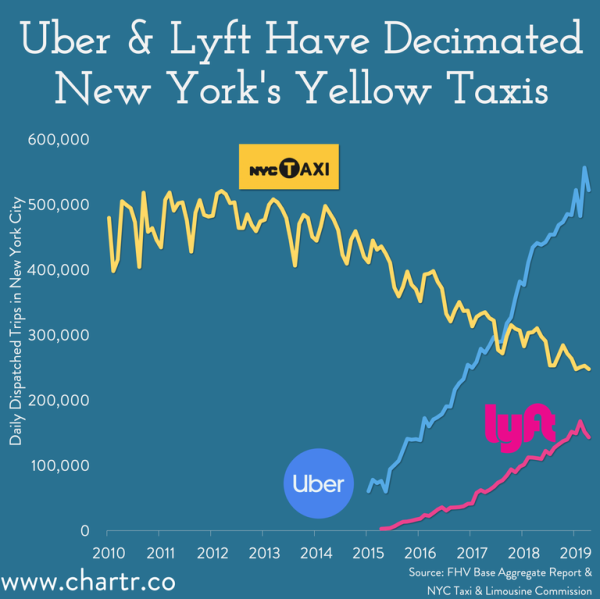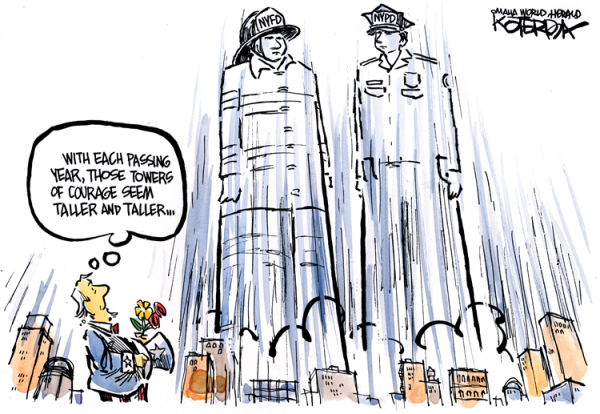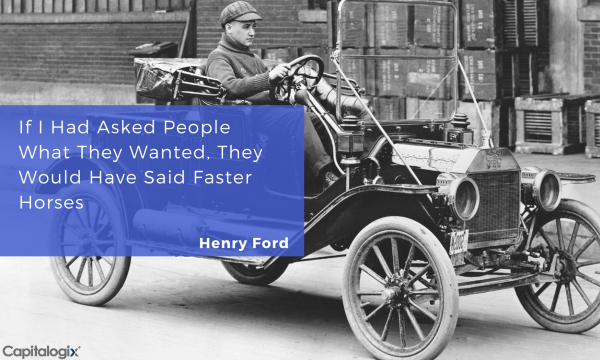Here's a little throwback for you. The front page of a Radio Shack ad.

Everything on that page can be found in your smart-phone today. Pretty cool!
Here's a little throwback for you. The front page of a Radio Shack ad.

Everything on that page can be found in your smart-phone today. Pretty cool!
I enjoy looking at great disruptive companies and great examples of industries that are primed for disruption.
Think about how many companies have failed due to myopia… Radioshack couldn't understand a future where shopping was done online and Kodak didn't think digital cameras would replace good ol' film. Blockbuster couldn't foresee a future where people would want movies in their mailboxes, because "part of the joy is seeing all your options!" They didn't even make it long enough to see "Netflix and Chill" become a thing.
The Taxi industry had been ready for disruption way before Uber came along, yet, Uber may have mismanaged their opportunity. Taxis now have a chance to innovate back.
To run a taxi in New York you need a medallion. There are approximately 13.5 thousand medallions in NYC. In 2013, prices peaked at over 1.3 million dollars for a single medallion.
The medallion system has been broken for a long time. NYC taxis, in particular, were corrupt and the prices of medallions were artificially inflated by Bloomberg and de Blasio, and built on a debt bubble.
Taxis offered mediocre service, high rates due to artificial caps/greed, and often didn't take credit cards.
They didn't adapt and got disrupted. It's an age-old tale. The same tale as Blockbuster or Kodak; companies thinking linearly in an age of exponential change.
Taxi agencies had the infrastructure to edge ridesharing out and adopt friendlier policies but were slow to adopt the apps and convenience that modeled ridesharing.

via chartr
It's clear that there's an increased demand for rides. Increased demand is likely caused by access in places that didn't previously have enough demand for a full taxi-service. Ridesharing means you can have drivers in small towns, rural areas, etc. Almost all the new demand is being monopolized by ridesharing.
Should it be, though?

Here are some of the posts that caught my eye recently. Hope you find something interesting.
When I think about the invention of the wheel, I think about cavemen. But that isn't how it happened.
Lots of significant inventions predated the wheel by thousands of years. For example, woven cloth, rope, baskets, boats, even the flute were all invented before the wheel (and apparently not invented by cavemen).
While simple, the wheel worked well (and still does). Even now, the phrase "reinventing the wheel" is used derogatorily to depict needless or inefficient effort. But how does that compare to sliced bread (which was also a pretty significant invention)?
Despite being a hallmark of innovation, it still took more than 300 years for the wheel to be used for travel. With a bit more analysis, it makes sense. In order to use a wheel for travel it needs an axle, and it needs to be durable, and loadbearing, requiring relatively advanced woodworking and engineering.

All the aforementioned products created before the wheel (except for the flute) were necessary for survival. That's why they came first. As new problems arose, so did new solutions.
Necessity is the mother of invention.
Unpacking that phrase is a good reminder that inventions (and innovation) are often solution-centric.
Too many entrepreneurs are attracted to an idea because it sounds cool. They get attracted to their ideas and neglect their ideal customer's actual needs.
If you want to be disruptive, cool isn't enough. Your invention has to be functional, and it has to fix a problem people have (even if they don't know they have it.) The more central the complaint is to their daily lives the better.

Henry Ford famously said: “If I had asked people what they wanted, they would have said faster horses.”
Innovation means thinking about and anticipating wants and future needs.
Your customers may not even need something radically new. Your innovation may be a better application of existing technology or a reframe of best practices.
Uber didn't create a new car, they created a new way to get from where you want with existing infrastructure and less friction.
Football season is officially underway! In honor of that, here's a look at each position's composite player!
As you might expect, different sports have a different ratio of ethnicities. For example, you might expect more Pacific Islanders in Rugby or Asians in Badminton.
The same is true for different positions on a football team. Apparently, offensive linemen are more likely to be white while running backs are more likely to be black.
Here is a visualization that shows what happens when you average the top players' faces in various positions?

Composites are interesting.
While you may be thinking "this player must be unstoppable" … statistically, he's average.
The "composite" NFL player would be the 848th best player in the league. He's not a starter, and he plays on an average team.
We found the same thing with our trading bots. The ones that made it through most filters weren't star performers. They were the average bots that did enough not to fail (but failed to make the list as top performers in any of the categories). The survivors were generalists, not specialists.
In an ideal world, with no roster limits, you'd want the perfect lineup for each granular situation. You'd want to evaluate players on how they perform under pressure, on different downs, against other players, and with different schemes.
That's what technology lets you do with algorithms. You can have a library of systems that communicate with each other … and you don't even have to pay their salary (but you will need data scientists, researchers, machines, data, alternative data, electricity, disaster recovery, and a testing platform).
You won't find exceptional specialists if your focus is on generalized safety. Generalists are great, but you also have to be able to respond to specific conditions.
Onwards.

Here are some of the posts that caught my eye recently. Hope you find something interesting.

Here are some of the posts that caught my eye recently. Hope you find something interesting.
Just saw this and thought it was worth sharing.
Can you guess what this picture shows?

The "thing" next to the fingernail is a functioning computer created at the University of Michigan (and it measures just .3 mm a side). It's run by photovoltaics and is primarily used as a precision temperature sensor. The caveat is that once it loses power, it loses all prior programming and data.
It tests the limits of what we call a computer – but it's multitudes better than the previous iteration, and innovation breeds innovation.
Exciting stuff!
Larry Kudlow confirmed that Trump wants to buy Greenland.

Here are some of the posts that caught my eye recently. Hope you find something interesting.
AI has plenty of weaknesses – I've talked about some before, and I'll continue to talk about them in the future, but two specific weaknesses were brought to my attention this week.
I assume most of you have seen the FaceApp trend – people age-ifying their photos and unwittingly giving the rights to their photos to a shadowy Russian tech company. You've also likely seen AI paintings selling for ridiculous money.
But have you seen their lovechild AI Portraits – a more wholesome experiment run by the MIT-IBM Watson AI Lab. AI Portraits uses approximately 45,000 different Renaissance-esque 15th-century portraits and General Adversarial Networks to translate your selfie into an artistic masterpiece. It's novel because instead of simply drawing over your face it's generating new features and creating an entirely new version of your face.
Mauro Martino via YouTube
It's impressive because it determines the best style for your portrait based on your features, your background, and more.
However, it's not without "flaw". The choice of 15th-century portraiture creates a couple of clear biases. At the time, portraits of smiling or laughing individuals were rare, so your smile will likely not transfer. As well, there's a clear bias towards anglo-saxonification.

via AI Portraits
My son got excited while playing with the app and sent several of his coworkers, friends, and family through the app. If you look at the bottom right, you'll see my lovely wife Jen's portrait.
Most of you have seen my wife and know that she is Indonesian, something that is very much removed from the translation.
You can also see it in Beyonce's AI portrait.

via MyModernMet
All photos are immediately deleted from their servers after creating your image, so your privacy is safe (this time!)
All biases can be considered quirks of this current iteration of the program – which I do earnestly believe is interesting.
Later, you can imagine an AI choosing between various different styles of art based on a cornicopia of factors – or off human selection – but you have to walk before you can run, and this is a fun way to get people excited about AI.
“Yes…Life, the Universe, and Everything. There is an answer. But I’ll have to think about it…the program will take me seven-and-a-half million years to run.” – Deep Thought, Hitchhiker's Guide To The Galaxy
Think of the global excitement when IBM's Watson first beat Ken Jennings in Jeopardy … it's widely considered one of the holy grails of AI research to create a machine that truly understands the nuances of language and human thought. Yet, if you've talked to Alexa recently, you know there's a long way to go.
Today's question answering systems are basically glorified document retrieval systems. They scan text for related words and send you the most relevant options. Researchers at the University of Maryland recently figured out how to easily create questions that stump AI (without being paradoxical, impossible to answer, requiring empathy etc.) in order to enhance those systems.
A system that understands those questions will be a massive step toward a real understanding and processing of language.
So what's the secret to these "impossible" questions?
From the University of Maryland article:
The questions revealed six different language phenomena that consistently stump computers. These six phenomena fall into two categories. In the first category are linguistic phenomena: paraphrasing (such as saying “leap from a precipice” instead of “jump from a cliff”), distracting language or unexpected contexts (such as a reference to a political figure appearing in a clue about something unrelated to politics). The second category includes reasoning skills: clues that require logic and calculation, mental triangulation of elements in a question, or putting together multiple steps to form a conclusion […]
For example, if the author writes “What composer's Variations on a Theme by Haydn was inspired by Karl Ferdinand Pohl?” and the system correctly answers “Johannes Brahms,” the interface highlights the words “Ferdinand Pohl” to show that this phrase led it to the answer. Using that information, the author can edit the question to make it more difficult for the computer without altering the question’s meaning. In this example, the author replaced the name of the man who inspired Brahms, “Karl Ferdinand Pohl,” with a description of his job, “the archivist of the Vienna Musikverein,” and the computer was unable to answer correctly. However, expert human quiz game players could still easily answer the edited question correctly.
The main change is increasing the complexity of the questions by nestling another question. In the above example, the second question forces the AI not only to decide the composer inspired by Karl Ferdinand Pohl, but also to decipher who is inspiring (hint: It's Karl Ferdinand Pohl).
AI isn't great yet at mental triangulation; at putting together multiple steps to form a conclusion. While AI is great at brute force applications – we're still coding the elegance.

via Gaping Void